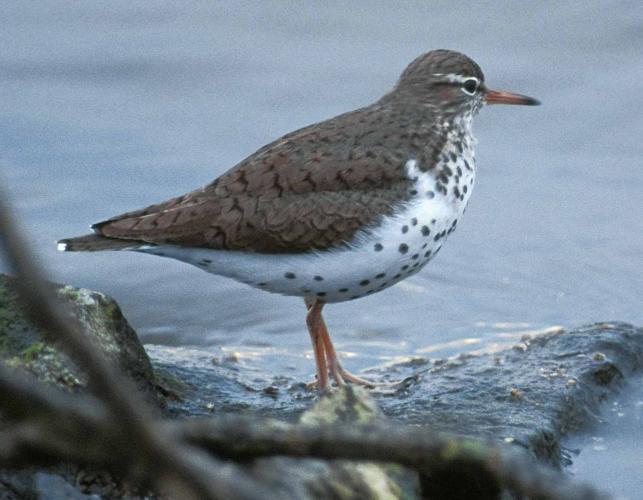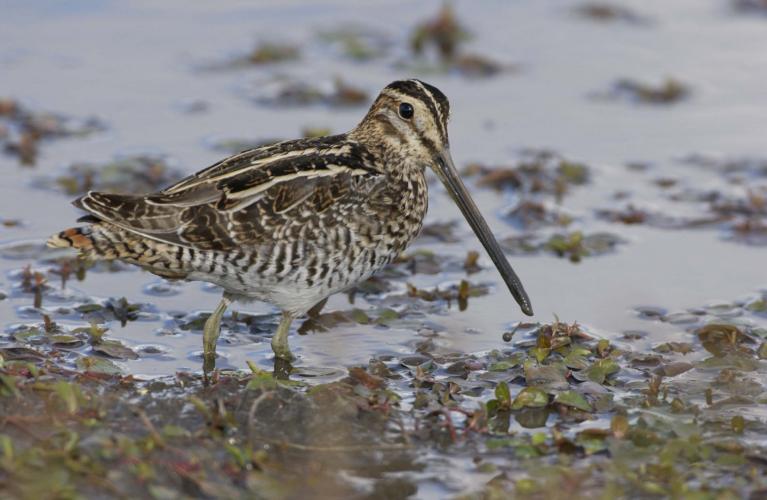In addition to waterfowl, several other groups of birds are frequently associated with wetlands. Among these are shorebirds, which are represented in Missouri by more than 40 migrant species. Shorebirds, such as dowitchers, sandpipers, and yellowlegs, typically have long, somewhat flexible bills for picking and probing for food and fairly long legs for wading in shallow water.
Although four shorebird species — killdeer, upland and spotted sandpiper, and American woodcock — regularly nest throughout Missouri, none of the four nests in wetlands. Therefore, management activity should be directed toward providing feeding and resting habitat during spring and fall migration, rather than during the breeding season.
Shorebird Habits and Habitat
The food habits, feeding behavior, and habitat requirements of shorebirds differ from those of migrant waterfowl and warrant some special consideration in the design and management of wetland areas.
Most shorebirds prefer feeding areas that include shallow water up to 3 inches deep and exposed, bare mud flats containing short, sparse vegetation. Shorebirds migrate later in the spring and earlier in the fall than most waterfowl.
Title
Selecting Wetland Sites for Shorebirds
If two or more impoundments are available, one should be flooded early in July, the other in September. The following criteria must be considered when selecting a site and developing it:
- Sites on rich bottomland soils offer the greatest potential.
- Sites containing areas of porous sands should be avoided.
- Impoundments as small as one to two acres can be successfully managed for migrant shorebirds; however, larger areas can be managed more efficiently for shorebirds and will provide habitat for migrant waterfowl at the same time.
- Levee heights should be lower than those for waterfowl marshes, because shorebirds prefer to feed in water that is three inches or less.
Title
Management Practices by Season
In spring:
- Keep the same water level throughout the winter.
- During the last week of March and first week of April, drawdown water gradually to expose only the most elevated areas.
Shorebird migrations usually continue through the first week of June. This spring-management sequence is compatible with waterfowl, since deeper water habitats are available during peak duck migrations in late February or March. The shallow areas created by the initial drawdown for shorebirds also are attractive to most late migrant puddle ducks, such as shovelers and teal.
In fall:
Shorebirds begin fall migration in midsummer. Management of wetlands at this time requires a different strategy than used in the spring. Impoundments that often contain water in the spring become dry and covered with vegetation by midsummer.
Disking followed by shallow flooding in July will provide excellent shorebird areas. Disking reduces the dense summer vegetation, creates bare soil, and exposes insects found below the surface. Flooding up to a 3-inch depth creates a habitat that is used almost immediately by migrant shorebirds.
The major challenge of fall shorebird management is maintaining high-quality habitat throughout the lengthy migration period. Solitary and least sandpipers arrive by July 1; the long-billed dowitchers and dunlins persist until the water freezes, often in early November.
Title
Water Levels for Shorebirds
- The depth of the water should be sufficient to allow for the gradual drawing down over the period from late March through the first week of June.
- The drawdown rate must be based on the available water supply, the slope of the ground, and the evaporation rate. Care must be taken to ensure that water is not released so rapidly that it creates premature drying while migrant birds are still present.
- A dependable source of water must be available for July impoundment flooding for the late summer and fall migration period. The water requirements may be met by pumping from a well, stream, nearby lake or higher reservoir.
- Several types of water-level control structures are possible, but whichever one you choose, make sure it allows you to change the water level in increments as small as one-half inch and to rapidly and completely drain the impoundment. A stop-log type of control structure is best. It allows changes in water elevations by adding or removing fitted boards of varying thicknesses.
- The presence of raised hills or mounds within an impoundment increases the attractiveness of the area for shorebirds, because of the presence of drier sites for resting and preening and a greater shoreline area for feeding.
- If possible, large impoundments should be subdivided so that several water depths and management strategies are possible, resulting in greater wildlife diversity.
- Interior levees should be constructed along contours, preferably at 6-inch contour intervals.




































